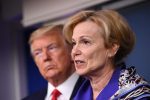Do I need to announce this every day? The pandemic is not over. If you drop your guard, it can still get you.
New coronavirus cases in the United States continued to rise in the past week, jumping by as much as 12 percent nationwide, as senior officials implored Americans to stick to public health measures to help reverse the trend.
The seven-day average of new cases topped 63,000 for the first time in nearly a month, according to data compiled by The Washington Post, while states such as Michigan, Vermont and North Dakota reported substantial spikes in new infections. The nation appeared poised for a fourth wave of illness even as vaccine eligibility is expanding in many states.
Michigan led the nation in new cases with a 57 percent rise over the past week. The state, which relaxed covid-related restrictions earlier this month, also reported the largest increase in coronavirus hospitalizations, which grew by more than 47 percent.
The virus is still circulating everywhere. You’re swimming in it. The prevalence is still high, so even if you personally have been vaccinated, the virus still has tentacles of infection everywhere. We aren’t really safe until almost everyone is safe. Right now, I’ve got students going into quarantine and dropping out of our ongoing genetics experiment, and it’s not the kind of thing where you can take a few weeks to recover and pick up where you left off — the flies keep doing their thing whether you show up to analyze them or not. So I’m suddenly faced with a need to make all kinds of accommodations, and hope that enough students stay healthy that we can carry through to the end. This does not feel like the pandemic is over. It feels a lot like March of last year, when so many students were getting sick that we had to shut down the lab for the remainder of the term.
Meanwhile, we got people like the Libertarians of Kentucky, who make odious comparisons between more pandemic safety and the Holocaust.
Are the vaccine passports going to be yellow, shaped like a star, and sewn on our clothes?
— Libertarian Party of Kentucky (@lpky) March 29, 2021
If the Star of David tweet didn't make it clear, The Libertarian Party of Kentucky is against #Vaccinespassports as they are a complete and total violation of human liberty.
This is the stuff of totalitarian dictatorships.
— Libertarian Party of Kentucky (@lpky) March 29, 2021
Right. We’ve got a country full of assholes who consider the ability to spread disease to be an essential part of “human liberty”.
Everyone who is not a selfish, entitled git: get vaccinated, get tested, wear a mask, maintain social distancing, don’t start partying in bars just yet.


